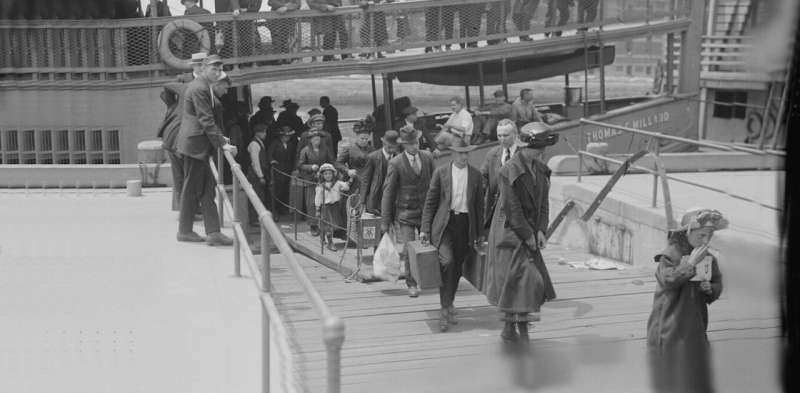Discovering the 'honeypot': The surprising way restricting immigration can turn out to hurt the working poor

Politicians around the world tout immigration restrictions as a way to fight wage stagnation and boost the job prospects of low-paid or unemployed locals.
The Trump administration pushed the message aggressively, at one stage calling a proposal to halve migration numbers the RAISE Act (standing for Reforming American Immigration for a Strong Economy), saying it would raise workers' wages and help struggling families enter the middle class.
Whether or not cutting low-skilled migration would lift working class wages remains a highly contentious question.
My research examines the question in a broader way. Its findings—looking back at an extraordinary time of change in U.S. history, from the 1880s on—suggest that while restricting immigration might at first help low-income workers, over time it hurts those local workers. This is due to what I call the "honeypot effect," in which wage hikes for poor jobs keep people in poor jobs.
The problem is that there are very few real-world immigration restrictions to examine. Immigration to the global West has been rising steadily since the 1960s.
The COVID pandemic essentially eliminated immigration for a short time, but it is as good as impossible to isolate the effects of that from the effects of everything else that was going on at the same time.
America's first exclusion: The Chinese Exclusion Act of 1882
Up until 1882, the U.S. had an open-border policy with virtually no restrictions on entry. The Chinese Exclusion Act—introduced that year in response to the widespread belief that low-skilled Chinese immigrants were responsible for depressed wages and unemployment—was a first.
It was also long-lasting. It completely prohibited the immigration of Chinese laborers for more than fifty years.
It represents an ideal so-called "natural experiment." Because Chinese immigration had been very heavily concentrated in certain locations, its impact was isolated to those locations, allowing what happened where it did restrict immigration to be compared to what happened where it did not.
And I discovered there was data. The U.S. Government fully discloses Census data after 72 years. This allowed me to link individuals across U.S. censuses to track the employment situation of millions of Americans over the entirety of their working lives.
A significant, negative, long-term effect
What I found was surprising. The Chinese Exclusion Act had a significant, negative long-term effect on American workers. My estimate is that workers in locations exposed to the Act earned on average 6–15% less over their working lives than their counterparts in other locations
The negative effects were strongest for low-skilled and unemployed workers.
The exclusion of Chinese immigrants not only failed to improve conditions for working-class Americans, but made them substantially worse off in the long run.
The honeypot and the occupational ladder
Then I set out to examine this seemingly counter-intuitive result: why shortages of low-skilled labor had led to worse long-term outcomes for low-skilled workers.
The answer appears to lie in a "honeypot" effect.
A closer look suggests the Chinese Exclusion Act was initially successful in boosting low-skilled wages and the employment of Americans in low-skilled jobs in the regions it had an effect.
This created a "honeypot"—American workers in those locations increasingly took and remained in low-skilled jobs. They became significantly less likely to become educated, meaning they fell behind their counterparts in other locations on the occupational ladder.
And their initial wage gains were short-lived, with increased arrivals from other countries and other parts of the U.S. eventually filling the labor shortages.
This left the workers who had opted to stay in low-skilled jobs stuck with low pay, depressing their lifetime earnings compared to their counterparts in regions unaffected by the Chinese Exclusion Act.
Underlying the honeypot effect is the reality that most workers progress up an occupation ladder over their working lives, often as a result of education and training.
But education involves trade-offs. It can require giving up immediate income to earn more down the track.
Immediate income which is higher is harder to give up.
And there might be another mechanism at play. When low-skilled workers are in short supply, there might be fewer high-skilled jobs on offer because high-skilled jobs need low-skilled jobs to complement them.
Implications for today
The economy of 1882 bears little resemblance to today's economy and we should take care in drawing general conclusions.
However, studies of modern immigration inflows into the United States and Europe also find they boost the education and occupational status of native workers, suggesting the processes underlying the honeypot effect are present in modern economies.
Immigration restrictions are too blunt an instrument and their effects are too complex to be used to boost wages and employment.
My findings suggest that even if restrictions are successful in creating wage gains for some in the short run, they are just as likely to lead to negative outcomes for locals in the long run.
This is not to say that increasing low-skilled wages is a bad thing. But immigration restrictions can only create temporary, unsustainable wage increases.
There are better, more sustainable ways to help low-skilled workers, backed by stronger evidence.
Attempts to help low-skilled workers should promote—or at the very least not discourage—education and occupational upgrading. That way they would help the low-skilled workers and the economy as a whole.
Provided by The Conversation
This article is republished from The Conversation under a Creative Commons license. Read the original article.![]()
No comments:
Post a Comment